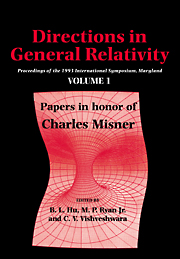 Directions in General Relativity
Directions in General Relativity Book contents
- Frontmatter
- Contents
- Contributors
- Symposium Program
- Papers from both Volumes Classified by Subject
- Preface
- Charles W. Misner: Insight and Discovery
- Remarks Concerning the Geometries of Gravity and Gauge Fields
- Gravity and Unification of Fundamental Interactions
- Minisuperspaces: Symmetries and Quantization
- Quantum Cosmology
- A Pictorial History of some Gravitational Instantons
- No Time Machines from Lightlike Sources in 2+1 Gravity
- Inhomogeneity and Anisotropy Generation in FRW Cosmologies
- Misner, Kinks and Black Holes
- The Quantum Mechanics of Closed Systems
- Cosmological Vacuum Phase Transitions
- Minisuperspace as a Quantum Open System
- Ricci Flow on Minisuperspaces and the Geometry-Topology Problem
- Classical and Quantum Dynamics of Black Hole Interiors
- Matter Time in Canonical Quantum Gravity
- The Isotropy and Homogeneity of the Universe
- Recent Advances in ADM Reduction
- Some Progress in Classical Canonical Gravity
- Harmonic Map Formulation of Colliding Electrovac Plane Waves
- Geometry, the Renormalization Group and Gravity
- An Example of Indeterminacy in the Time-Development of “Already Unified Field Theory”: A Collision between Electomagnetic Plane Waves
- Non-static Metrics of Hiscock-Gott Type
- Non-Standard Phase Space Variables, Quantization and Path-Integrals, or Little Ado about Much
- The Present Status of the Decaying Neutrino Theory
- Exploiting the Computer to Investigate Black Holes and Cosmic Censorship
- Misner Space as a Prototype for Almost Any Pathology
- Relativity and Rotation
- The First Law of Black Hole Mechanics
- Gravitational Radiation Antenna Observations
- The Back-Reaction is Never Negligible: Entropy of Black Holes and Radiation
- Toward a Thesis Topic
- Charles Misner: A Celebration of Memories
- Curriculum Vitae of C. W. Misner
- Ph. D. Theses supervised by C. W. Misner
- List of Publications of C. W. Misner
Exploiting the Computer to Investigate Black Holes and Cosmic Censorship
Published online by Cambridge University Press: 03 February 2010
- Frontmatter
- Contents
- Contributors
- Symposium Program
- Papers from both Volumes Classified by Subject
- Preface
- Charles W. Misner: Insight and Discovery
- Remarks Concerning the Geometries of Gravity and Gauge Fields
- Gravity and Unification of Fundamental Interactions
- Minisuperspaces: Symmetries and Quantization
- Quantum Cosmology
- A Pictorial History of some Gravitational Instantons
- No Time Machines from Lightlike Sources in 2+1 Gravity
- Inhomogeneity and Anisotropy Generation in FRW Cosmologies
- Misner, Kinks and Black Holes
- The Quantum Mechanics of Closed Systems
- Cosmological Vacuum Phase Transitions
- Minisuperspace as a Quantum Open System
- Ricci Flow on Minisuperspaces and the Geometry-Topology Problem
- Classical and Quantum Dynamics of Black Hole Interiors
- Matter Time in Canonical Quantum Gravity
- The Isotropy and Homogeneity of the Universe
- Recent Advances in ADM Reduction
- Some Progress in Classical Canonical Gravity
- Harmonic Map Formulation of Colliding Electrovac Plane Waves
- Geometry, the Renormalization Group and Gravity
- An Example of Indeterminacy in the Time-Development of “Already Unified Field Theory”: A Collision between Electomagnetic Plane Waves
- Non-static Metrics of Hiscock-Gott Type
- Non-Standard Phase Space Variables, Quantization and Path-Integrals, or Little Ado about Much
- The Present Status of the Decaying Neutrino Theory
- Exploiting the Computer to Investigate Black Holes and Cosmic Censorship
- Misner Space as a Prototype for Almost Any Pathology
- Relativity and Rotation
- The First Law of Black Hole Mechanics
- Gravitational Radiation Antenna Observations
- The Back-Reaction is Never Negligible: Entropy of Black Holes and Radiation
- Toward a Thesis Topic
- Charles Misner: A Celebration of Memories
- Curriculum Vitae of C. W. Misner
- Ph. D. Theses supervised by C. W. Misner
- List of Publications of C. W. Misner
Summary
ABSTRACT
We describe a method for the numerical solution of Einstein's equations for the dynamical evolution of a collisionless gas of particles in general relativity. The gravitational field can be arbitrarily strong and particle velocities can approach the speed of light. The computational method uses the tools of numerical relativity and N-body particle simulation to follow the full nonlinear behavior of these systems. Specifically, we solve the Vlasov equation in general relativity by particle simulation. The gravitational field is integrated using the 3 + 1 formalism of Arnowitt, Deser, and Misner. Our method provides a new tool for studying the cosmic censorship hypothesis and the possibility of naked singularities. The formation of a naked singularity during the collapse of a finite object would pose a serious difficulty for the theory of general relativity. The hoop conjecture suggests that this possibility will never happen provided the object is sufficiently compact (≲M) in all of its spatial dimensions. But what about the collapse of a long, nonrotating, prolate object to a thin spindle? Such collapse leads to a strong singularity in Newtonian gravitation. Using our numerical code to evolve collisionless gas spheroids in full general relativity, we find that in all cases the spheroids collapse to singularities. When the spheroids are sufficiently compact the singularities are hidden inside black holes. However, when the spheroids are sufficiently large there are no apparent horizons. These results lend support to the hoop conjecture and appear to demonstrate that naked singularities can form in asymptotically flat spacetimes.
- Type
- Chapter
- Information
- Directions in General RelativityProceedings of the 1993 International Symposium, Maryland: Papers in Honor of Charles Misner, pp. 320 - 332Publisher: Cambridge University PressPrint publication year: 1993
